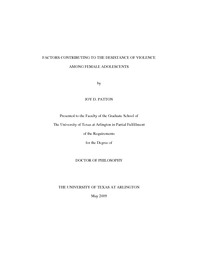| dc.description.abstract | The major focus of this study was to test the theory driven conceptual model derived from the literature regarding risk, protective and desistance factors and the relationship of these factors to violent behavior of female adolescents. This study utilized The National Longitudinal dataset to evaluate these measures. The conceptual model was developed from information based on Resilience Theory and Life Course Perspective as it relates to violent behavior in adolescents. Data from 2,031 female participants were included in the current study.A review of the existing empirical literature suggested that there were specific risk, protective and desistance factors that would have an influence on the likelihood of female adolescents participating in violent behavior. The risk factors were: family connections, school connections and history of abuse; the protective factors included: IQ (school achievement was used in proxy of IQ) and intolerant attitudes toward violence; the desistance factors were: parenthood, marriage and employment. The hypothesized MIMIC model suggested differences in violent behavior based on race, level of community support and level of subsidized income supports. The tested model showed that there were indeed differences in violent behavior based on the demographic characteristics of race (B = -.53, t = .04, p < .001), level of community support (B = -.55, t = .04, p < .001) and level of subsidized income supports (B = -.54, t = .04, p < .001).The results of the hypothesized SEM model suggested: (1) that each of the latent variables of risk (B = .06, t = .02, p < .001) and protective factors (B = -.07, t = .01, p < .001) were significantly directly associated with violent behavior, (2) the latent variable, desistance factors (B = .01, t = .06, p > .05), was not significantly directly associated with violent behavior, (3) there were mediating effects between risk factors, protective factors and violent behavior (B = -.12, t = .04, p < .05) and (4) there were no mediating effects between risk factors, desistance factors and violent behavior (B = -1.28, t = 2.99, p > .05). | en_US |


